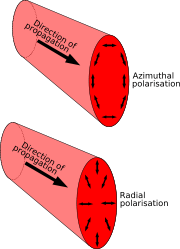Radial polarization
A beam of light has radial polarization if at every position in the beam the polarization (electric field) vector points towards the centre of the beam. In practice, an array of waveplates may be used to provide an approximation to a radially polarized beam. In this case the beam is divided into segments (eight, for example), and the average polarization vector of each segment is directed towards the beam centre.[1]

Radial polarization can be produced in a variety of ways. It is possible to use a liquid crystal device to convert the polarization of a beam to a radial state,[2] or a radially polarized beam can be produced by a laser, or any collimated light source, in which the Brewster window is replaced by a cone at Brewster's angle. Called a "Rotated Brewster Angle Polarizer," the latter was first proposed and put into practice (1986) to produce a radially-polarized annular pupil by Guerra [3] at Polaroid Corporation (Polaroid Optical Engineering Dept., Cambridge, Massachusetts) to achieve super-resolution in their Photon Tunneling Microscope. A metal bi-cone, formed by diamond-turning, was mounted inside a glass cylinder. Collimated light entering this device underwent two air-metal reflections at the bi-cone and one air-glass reflection at the Brewster angle inside the glass cylinder, so as to exit as radially-polarized light. A similar device was later proposed again by Kozawa [4] A related concept is azimuthal polarisation, in which the polarisation vector is tangential to the beam. If a laser is focused along the optic axis of a birefringent material, the radial and azimuthal polarizations focus at different planes. A spatial filter can be used to select the polarization of interest.[5]
A radially polarized beam can be used to produce a smaller focused spot than a more conventional linearly or circularly polarized beam,[6] and has uses in optical trapping.[7]
It has been shown that a radially polarized beam can be used to increase the information capacity of free space optical communication via mode division multiplexing,[8] and radial polarization can "self-heal" when obstructed.[9]
See also
References
- ↑ Saito, Y.; Kobayashi, M.; Hiraga, D.; Fujita, K.; et al. (March 2008). "z-Polarization sensitive detection in micro-Raman spectroscopy by radially polarized incident light". Journal of Raman Spectroscopy. 39: 1643. Bibcode:2008JRSp...39.1643S. doi:10.1002/jrs.1953.
- ↑ "Radial-Azimuthal Polarization Converter". Retrieved 2008-09-30.
- ↑ Guerra, John (1990). "Photon Tunneling Microscopy". Applied Optics. 29 (26): 3741–3752. Bibcode:1990ApOpt..29.3741G. doi:10.1364/AO.29.003741.
- ↑ Kozawa, Yuichi; Sato, Shunichi (2005). "Generation of a radially polarized laser beam by use of a conical Brewster prism". Optics Letters. 30 (22): 3063–3065. Bibcode:2005OptL...30.3063K. doi:10.1364/OL.30.003063. PMID 16315722.
- ↑ Erdélyi, Miklós; Gajdátsy, Gábor (2008). "Radial and azimuthal polarizer by means of a birefringent plate". Journal of Optics A: Pure and Applied Optics. 10 (5): 055007. Bibcode:2008JOptA..10e5007E. doi:10.1088/1464-4258/10/5/055007.
- ↑ Quabis, S.; Dorn, R.; Muller, J.; Rurimo, G.K.; et al. (2004). Radial polarization minimizes focal spot size. Quantum Electronics Conference 2004 (IQEC). Washington, OSA, Optical Society of America: Optical Society of America. pp. 615–616. doi:10.1109/IQEC.2004.242867. ISBN 1-55752-778-4.
- ↑ Qiwen Zhan (2004). "Trapping metallic Rayleigh particles with radial polarization". Optics Express. 12 (15): 3377–3382. Bibcode:2004OExpr..12.3377Z. doi:10.1364/OPEX.12.003377. PMID 19483862.
- ↑ Giovanni Milione; et al. (2015). "4 × 20 Gbit/s mode division multiplexing over free space using vector modes and a q-plate mode (de)multiplexer". Optics Letters. 40 (9): 1980–1983. arXiv:1412.2717. Bibcode:2015OptL...40.1980M. doi:10.1364/OL.40.001980.
- ↑ Giovanni Milione; et al. (2015). "Measuring the self-healing of the spatially inhomogeneous states of polarization of vector Bessel beams". Journal of Optics. 17 (3): 1–7. Bibcode:2015JOpt...17c5617M. doi:10.1088/2040-8978/17/3/035617.